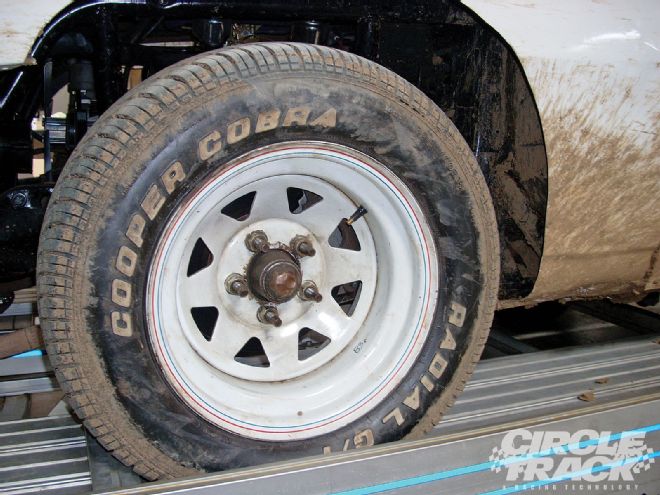
Editor's Note: This is the first of a two-part story that begins by reviewing some history and fundamentals of coatings, including a look at where the technology stands today, sprinkled with bits of advice and a few observations from authorities in the coatings and racing community.
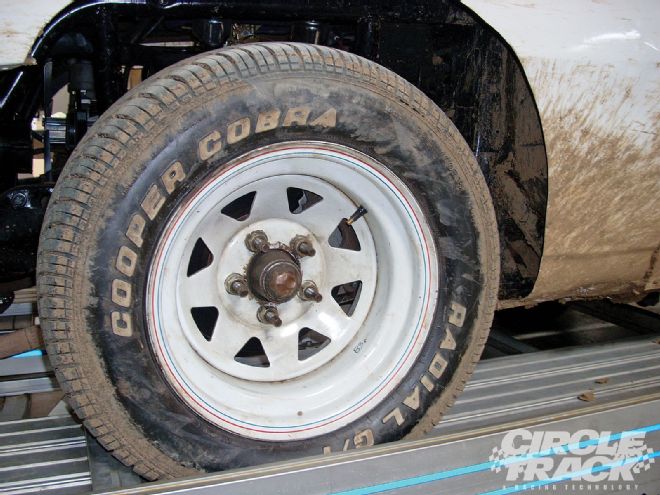 This wheel is as it came off the track. You'll note that there is plenty of mud on the car but none on the wheel since it has a coating on it.
This wheel is as it came off the track. You'll note that there is plenty of mud on the car but none on the wheel since it has a coating on it.
Historically speaking, what we'll call the "coatings industry" began to take root in the 1980s, according to current information sources, even though there was a modicum of activity prior to that period. At the time, there were two fundamental directions that began to emerge: plasma-spray coatings (initially applied to piston crowns and exhaust system components) and liquid coatings that focused on dry-film lubricants (both thermal barriers and thermal dispersants).
Plasma-sprays generally involved applying a "melted" coating material by spraying it onto a component or system to be protected. Liquid coatings are applied as such and then subjected to a curing process that then involves heating the coated part.
Much of the early coatings development occurred in the aerospace industry, while some products evolved from the commercial community, such as applications involving Teflon and various release coatings used in certain manufacturing processes. However, it wasn't long until enterprising people recognized that some of the technology had use in the automotive segment and growth in this area moved very quickly, particularly for the reduction of friction and heat found in engine bearings and valvesprings. Thermal dispersants were discovered to be particularly beneficial on these types of parts.
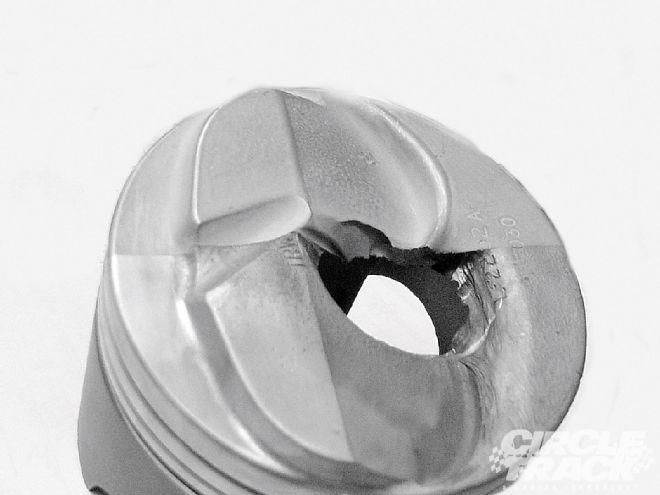 The piston with a hole is part of a test where half the piston was coated. A torch blew right through the uncoated part and you can see the line where the damage stopped with the coating. Only where the flame got under the coating was any loss experienced under the coating.
The piston with a hole is part of a test where half the piston was coated. A torch blew right through the uncoated part and you can see the line where the damage stopped with the coating. Only where the flame got under the coating was any loss experienced under the coating.
Then, moving into the late '80s and throughout the '90s, there was significant growth in the overall technology of motorsports. Interestingly, according to Leonard Warren (founder of Techline Coatings and a pioneer in that industry), the flow of new coatings development was turned around from how it began.
"Rather than being fed from the commercial and industrial side, the automotive community began to develop coatings technology that was flowing back into the commercial, industrial, and aerospace sectors. As an example, a coating Techline had developed for automotive mufflers became the coating specified for the exterior of a spacecraft to protect against re-entry temperatures. Essentially, we use that coating today as an air-drying thermal barrier for exhaust system components."
It appears that as the automotive applications and needs have increased because of rapid technological advances in other areas (including those outside the powertrain envelope), the diversity between the needs of aerospace and motorsports has grown wider, resulting in coatings requirements that are more applicable to the automotive environment than in space programs.
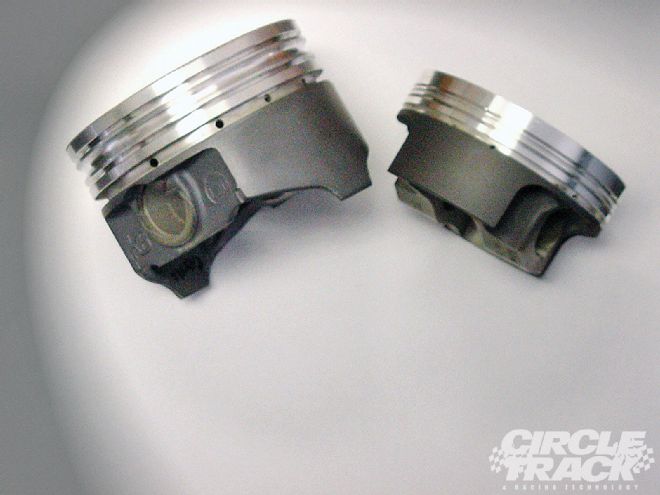 Coating piston skirts is intended to reduce friction horsepower and aid in maintaining cylinder wall finish and ring seal.
Coating piston skirts is intended to reduce friction horsepower and aid in maintaining cylinder wall finish and ring seal.
Parts life, durability, performance, pressures, and temperatures are all demands placed on parts intended for racing, and the fact these conditions are applied simultaneously to components and systems further complicates the requirements placed upon coatings. The need for coatings specialization has evolved in direct proportion to the ever-advancing and changing conditions in motorsports.
Again, according to Warren, "Coatings that were developed to meet the needs of racing just a few years ago, in many instances, are not sufficient for the needs we see in motorsports today. The stress and loads placed on parts today are greater than in the past. We've also seen a need to develop new coatings, especially thermal barrier products, to avoid some of the problems associated with the plasma-sprayed coatings."
Of the difficulties that can be linked with the plasma-spray approach, one deals with differences in thermal expansion rates between the coatings and base materials on which they are applied.
For example, plasma-sprayed bits of aluminum oxide can flake away from coated pistons (crowns) when used in a racing engine. This particular coating typically has a high Rockwell hardness level that can cause damage to other components (piston skirts, cylinder walls, and bearings) when small pieces of flaked coating are flushed into the oiling system, largely because of expansion and contraction rate differences between the coating and coated parts. Of course, this is not to say these types of coatings are not good for some applications because they can be. It's just additional reason that you should consult with your choice of coatings manufacturer or service provider to make proper materials and application selections.
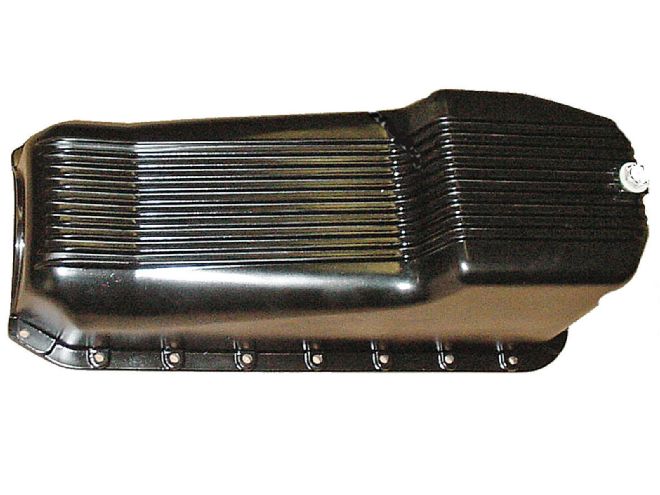 Thermal dispersants can be used to coat the exterior of oil pans, helping to achieve and maintain oil temperature control.
Thermal dispersants can be used to coat the exterior of oil pans, helping to achieve and maintain oil temperature control.
Over time, as the coatings industry has become more mature and specialized, there does not appear to be one coating that fits all applications. The technology has become not only more sophisticated but also more application-specific. As an example of this, there are piston crown coatings presently available that address different mechanical compression ratios. So a central point is that what we're calling the "coating technology" has become much more specialized than in the past, driven by greater demands placed on racing components and ongoing advances in the design and performance of these parts and systems themselves.
From a practical standpoint, how does the weekly circle-tracker apply this information and technology? Two factors come immediately into play-cost and needs. Perhaps we should reverse these two considerations. What may be needed in a Cup engine or car (because not all coatings apply to the powertrain) might be too costly in a Late Model or Modified, for example. Overkill is neither necessary, nor desirable. The weekend racer wants parts to last, go a bit faster, and save costs where possible. As a rule, addressing possible overheating issues, galling of friction surfaces, concerns about achieving and maintain piston ring seal, and increasing functional durability of parts are all areas common to those of us in this category of racers, and there are cost-effective coatings available that are specific to those needs. These topics are generally areas where addressing solutions with various types of coatings does not involve expensive technology or processes. In fact, based on parts manufacturer experience, some components are supplied pre-coated.
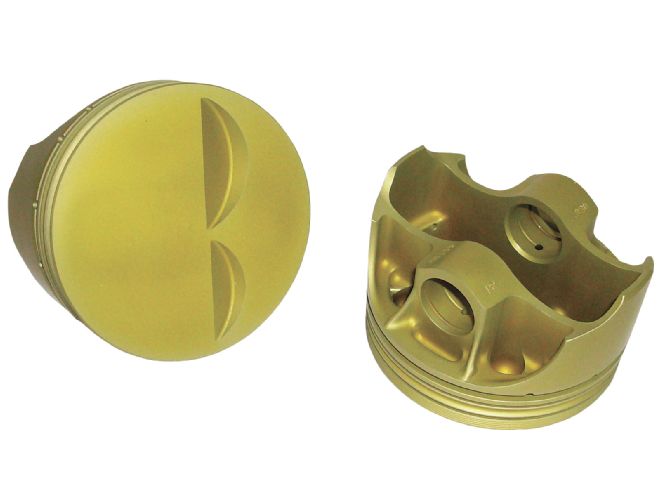 A new coating from Techline is designed to provide multiple benefits such as thermal barrier (piston crowns), friction reduction (piston skirts), ring seal, and oil temperature control (piston pin bosses)-all in one coating.
A new coating from Techline is designed to provide multiple benefits such as thermal barrier (piston crowns), friction reduction (piston skirts), ring seal, and oil temperature control (piston pin bosses)-all in one coating.
With regard to racers who find themselves in this category, there are basically two market segments. Says Warren, "For the guy who feels he has insufficient technological skills, there are literally hundreds of applicators scattered around the country that apply these types of lesser-expensive coatings at a reasonable price, for which their customers will see gains in horsepower, extended parts life, reduced operating temperatures, potentially better braking, and improvement in cooling system efficiency. For example, if I was building an engine and was working from the lowest possible budget, I would coat the pistons, bearings, and exhaust system. This is where you'll see the greatest power gain for the level of investment made, particularly since parts failures are often tied to these three areas."
From the standpoint of how best to get parts coated, it seems there are three types of people involved. There will be those who always want to apply the coatings themselves. In which case there are materials available, although toxicity problems are to be avoided for the DIY group, and a retail supplier of coatings can advise about this.
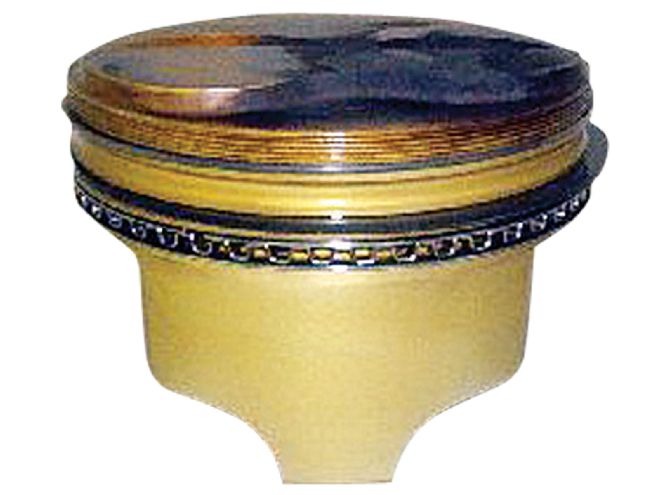 Traditionally, pistons skirts and crowns were coated with two different materials; a thermal barrier on the crown and friction-reduction material on the skirts, both of which address different dynamic conditions.
Traditionally, pistons skirts and crowns were coated with two different materials; a thermal barrier on the crown and friction-reduction material on the skirts, both of which address different dynamic conditions.
Then there are those who will never want to conduct the applications themselves and, as previously mentioned, there are many applicators who can perform this service at a reasonable cost. And finally, based on the complexity or cost of the process, some people will base their decision on these considerations and decide whether to be in the DIY group or have someone do it for them.
As a suggestion, given the amount of information that can be found on the Internet, relative to coatings, further research that includes discussions with coating materials suppliers and coating service providers is not a bad idea. And in your research, keep in mind (depending on which parts are being coated) that it's possible the engine "tune" will require some adjustment. This is particularly true if you're working in the combustion space. Don't forget, we're dealing with a heat machine where combustion temperature and work performed on the crankshaft are integrated. Spark timing and fuel calibration changes may come into play.
When asked about how much about coatings is being learned from work with NASCAR Cup cars, Tracy Trotter (president of Calico Coatings) responded, "We actually work with Cup teams and do a considerable amount of testing on our own. As an example of working with Cup cars, right now these engines are running flat-tappet cams. We've learned you can't run the cams currently being used without coated flat-tappet lifters. The parts just won't survive.
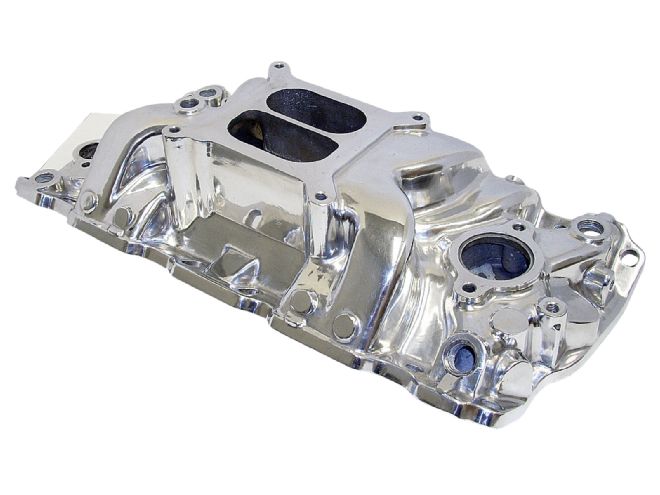 Techline's LTC coating creates a polished finish that never again requires application to maintain a high luster.
Techline's LTC coating creates a polished finish that never again requires application to maintain a high luster.
"I suppose there could be an engine re-design to go back to what they ran in the past, but they'd be down a significant amount of horsepower. So because of this, we're developing a new coating specifically for this application. We also buy one- or two-year-old Cup engines to do our own testing. This usually involves working with an engine builder or facility that has the most up-to-date testing equipment. From there, we'll work with a team who'll use the coating in practice engines and eventually in races."
Interestingly, coating materials and application processes are continually undergoing testing and evaluation, particularly since other factors influence what they need to accomplish, as previously mentioned. By working directly with race teams and engine builders who've had prior experience using and evaluating coatings, the suppliers and service providers are continually updating product lines to meet ever-changing demands and applications.
Moving outside powertrain, both coatings and surface finishing are currently in practice. Opinions vary on the amount of power that may or may not be gained by micro-finishing or super-finishing transmission gears but there's uniformity in the belief that durability can be extended by applying these processes. In fact, some contemporary coatings work best when applied to these type surfaces.
Are there specific benefits to coating various brake components? In Trotter's opinion, "We don't see much in that area any more. Benefits from this seem to have come and gone. Ten or 15 years ago, before we began seeing better cooling for brakes, bigger brakes and improvement in areas where coatings were previously of benefit. But based on some of things we're seeing today, coating of certain brake parts may come back into play. We're on the threshold of doing some coating and testing again, but it's not our highest priority right now."
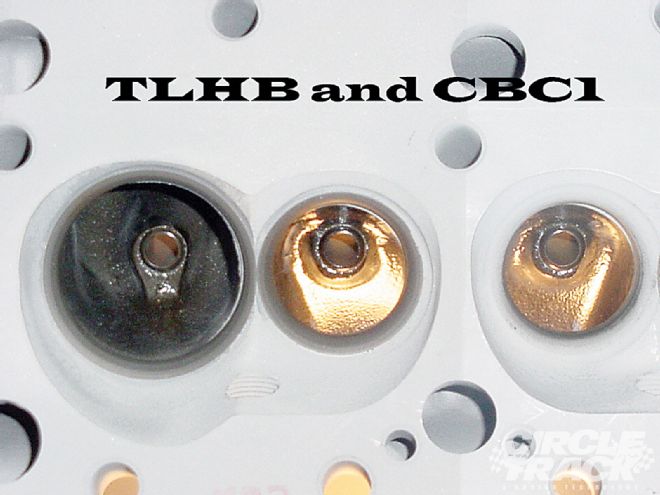 Typically, exhaust ports can be coated with a thermal barrier to reduce heat absorbed in the cooling system, minimize cylinder head distortion, and aid overall heat management in the exhaust system.
Typically, exhaust ports can be coated with a thermal barrier to reduce heat absorbed in the cooling system, minimize cylinder head distortion, and aid overall heat management in the exhaust system.
What's on the general horizon for coatings of the future? It appears we'll see cutting-edge coatings become thinner than today's, there will be further improvements in how they function, and indications are the cost of materials and application processes may decrease. Comments from the coating industry are that it's on a very fast pace right now, and because of the mobility of the demands placed upon both materials and services will continue to advance the technology. That's pretty much an overview.
Looking beyond generalities of what may lie ahead, there are some existing coatings that have been around for a time but not received much attention. An example of this might be so-called "clear coat" materials that tend to shed mud, if the track is dirt. There are other spray-on, air-dry coatings that either reduce the time required to clean a race car on a short-term basis or some that have a much longer use life.
These are among the coatings that seem to be gaining in popularity, rather than materials that represent new compounds or thinking. However, there are additional coatings coming to market on an ongoing basis. Among them are spray-on thermal barrier coatings that can be applied to the backs of disc brake pads to reduce heat transfer into the calipers. Thermal dispersants can be applied to calipers to reduce brake fluid temperature.
Indications (at least from Techline) are that new coatings on the horizon may include materials that address multiple functions, whereas it may have previously required more than one coating process on a single part to accomplish the same net objective. You may want to watch for that.
What should be understood is that existing coatings can be applied to numerous areas on a race car, outside the engine and powertrain package. Even shock absorbers are not immune from the possibility of improved operating temperatures, with the intent being to help these types of parts function more within their design limits, in terms of fluid temperature and control. Perhaps another view is that the use of thermal barrier and dispersant coatings enable a racer to "manage" race car heat in a way that improves its overall on-track efficiency.
It's fair to say that although certain engine and powertrain components (pistons, bearings, and headers) are frequent targets for knowing and learning about coatings, there are multiple other areas where friction or heat management can benefit from existing materials and processes. Of course, that isn't meant to imply new coatings won't continue to be introduced because they will be.
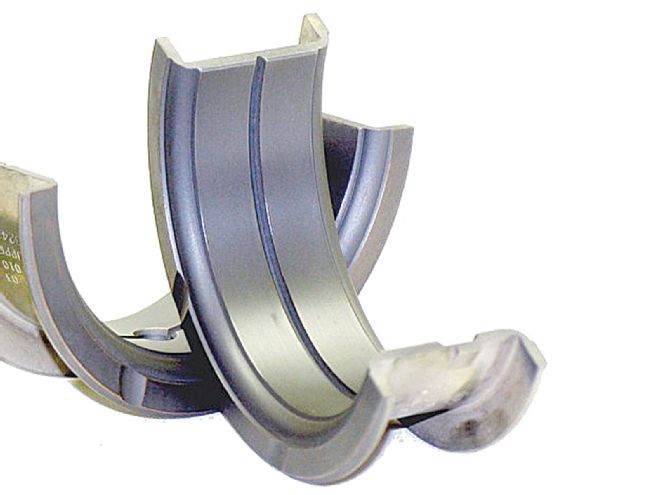 One of the lesser-expensive areas to coat focuses on connecting rod, main, and cam bearings. The life of core components in these applications (crankshaft bearing journals and camshafts) stands to improve, thereby offering the potential for less frequent rebuilds and parts cost.
One of the lesser-expensive areas to coat focuses on connecting rod, main, and cam bearings. The life of core components in these applications (crankshaft bearing journals and camshafts) stands to improve, thereby offering the potential for less frequent rebuilds and parts cost.
Just keep in mind that hard parts technology is also a moving and evolving target. Hard parts design refinements that include improved materials may not respond to coatings the way earlier versions of the same parts may have responded.
For example, as valvespring technology continues to advance, coatings applied to former spring material may not be required today-or at least require the same coating compound as before. And while the developers and manufacturers of coatings are aware of this changing landscape, it further underscores the importance of communicating with your choice of retail source or service provider, just to make certain of getting the most up-to-date information pertaining to your specific requirements.
Primary Categories Of Coatings
Thermal Barriers
These are just as the term implies-insulators or coatings that aid in the retention of heat in a way that improves engine performance or parts life. For example, such areas as piston crowns, combustion chambers, intake or exhaust valve faces or exhaust system components can benefit from the use of coatings that have thermal retention or insulating properties. It's important to understand and remember that we're dealing with a heat machine where power equates with heat, in a controlled environment. In other words, if the heat of combustion that should be released as "work" done on the rotating and reciprocating parts of an engine becomes liberated to other areas counterproductive to this objective (cooling system, combustion surfaces, atmosphere, and so on), net power will be reduced. However, as pointed out in the core story, it's not a bad idea to consult with your choice of coating materials manufacturer or supplier to determine not only the full ranges of coatings and/or coatings services available before making a decision about which thermal barrier material (or any other type coating for that matter) might be best for your particular application. But by definition, thermal barrier materials are intended to retain heat.
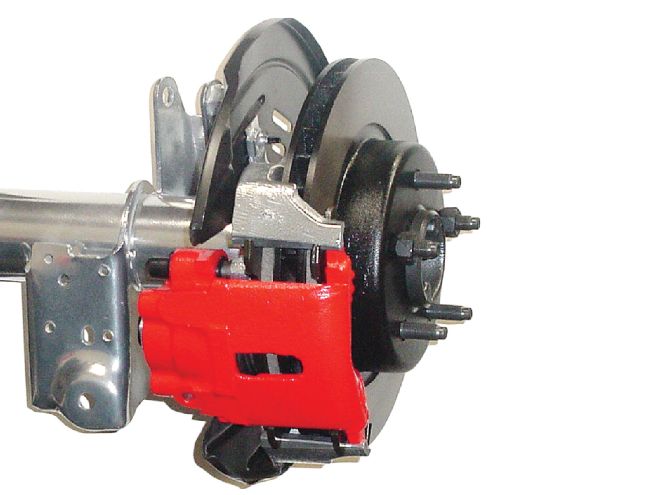 Brake components also can be coated, but recently better brake cooling technology has slowed their development.
Brake components also can be coated, but recently better brake cooling technology has slowed their development.
Thermal Dispersants
Again, the name is linked directly to the function. Thermal dispersants are intended to help remove heat from areas where a particular part or system benefits from a reduction in temperature build-up. These coatings are of value where either ongoing heat concentration or even temperature spikes are present and unwanted. Brake system components and oil pans are frequent targets for thermal dispersants. And here's something to not overlook. Sometimes, an effective thermal dispersant will allow you to re-think how a particular part or system is designed. For example, by rapid dispersion of excessive cooling system heat, a properly coated radiator may allow you to reduce the part's overall size, thereby providing an opportunity to reduce the car's frontal area and, accordingly, decrease net aerodynamic drag. In a sense, that's equivalent to an increase in power available to propel the race car. Benefits from sensible use of coatings is not always confined to heat or friction control.
Dry Film Lubricants
Relative to engine performance, a reduction in friction horsepower nets a gain in power at the flywheel. Mathematically speaking, friction horsepower is the numerical difference between ihp (indicated horsepower) and bhp (brake horsepower). In other words, brake horsepower increases as friction horsepower decreases. Dry film lubricants, in terms of horsepower, tend to reduce friction horsepower, in addition (in many instances) decreasing the operating and work-surface temperature of parts coated with DFLs. Examples of parts that can benefit from this type of coating include valvesprings, piston skirts and pins, bearings (rod, main, and camshaft), and oil pump gears. In many cases, manufacturers of these types of parts offer them pre-coated or will perform that service for you, if requested. But as previously suggested, it's generally a good idea to consult with your choice of either the suppliers of coatings materials or parts manufacturers to get their views on which coatings may be best for your particular application and needs, or both.